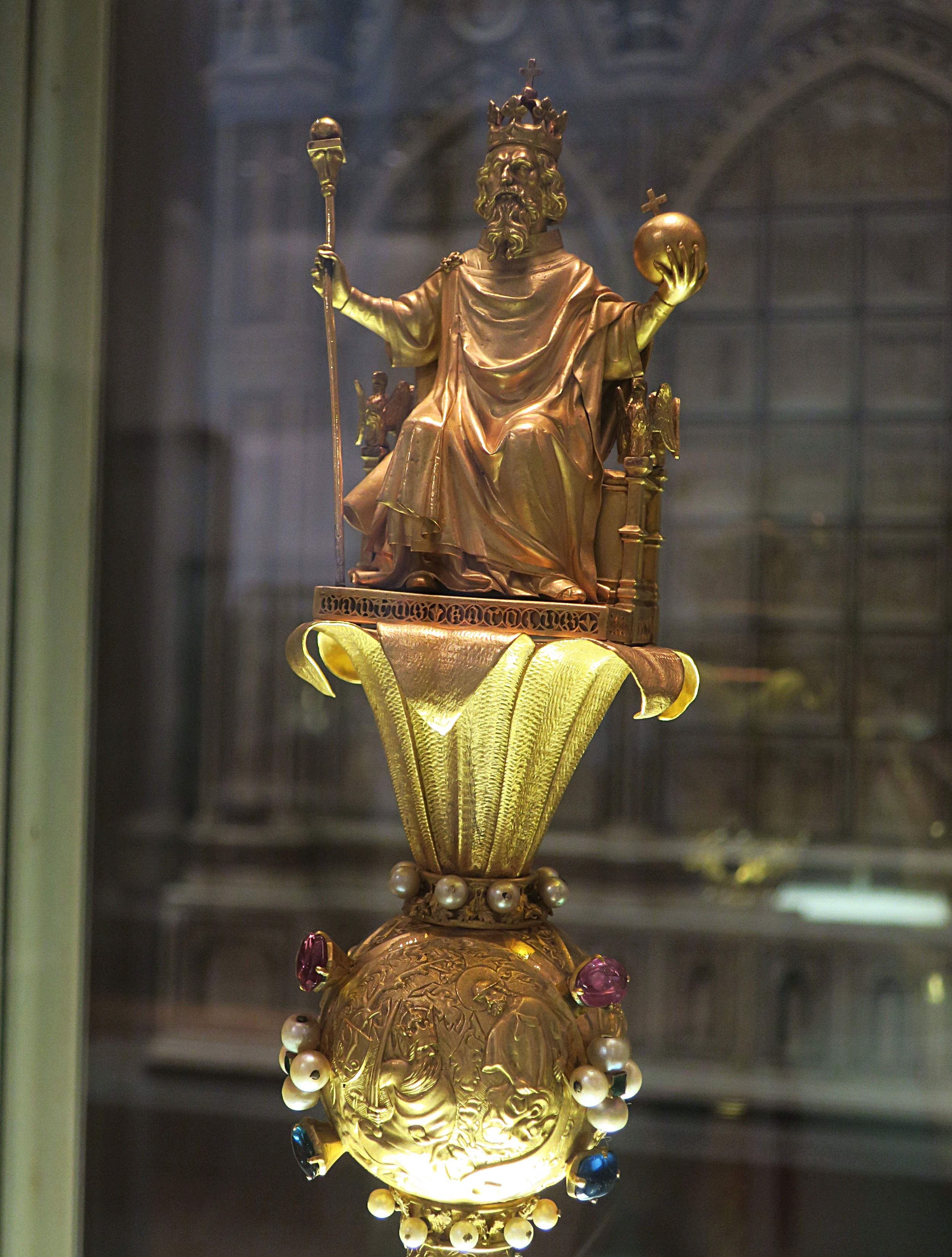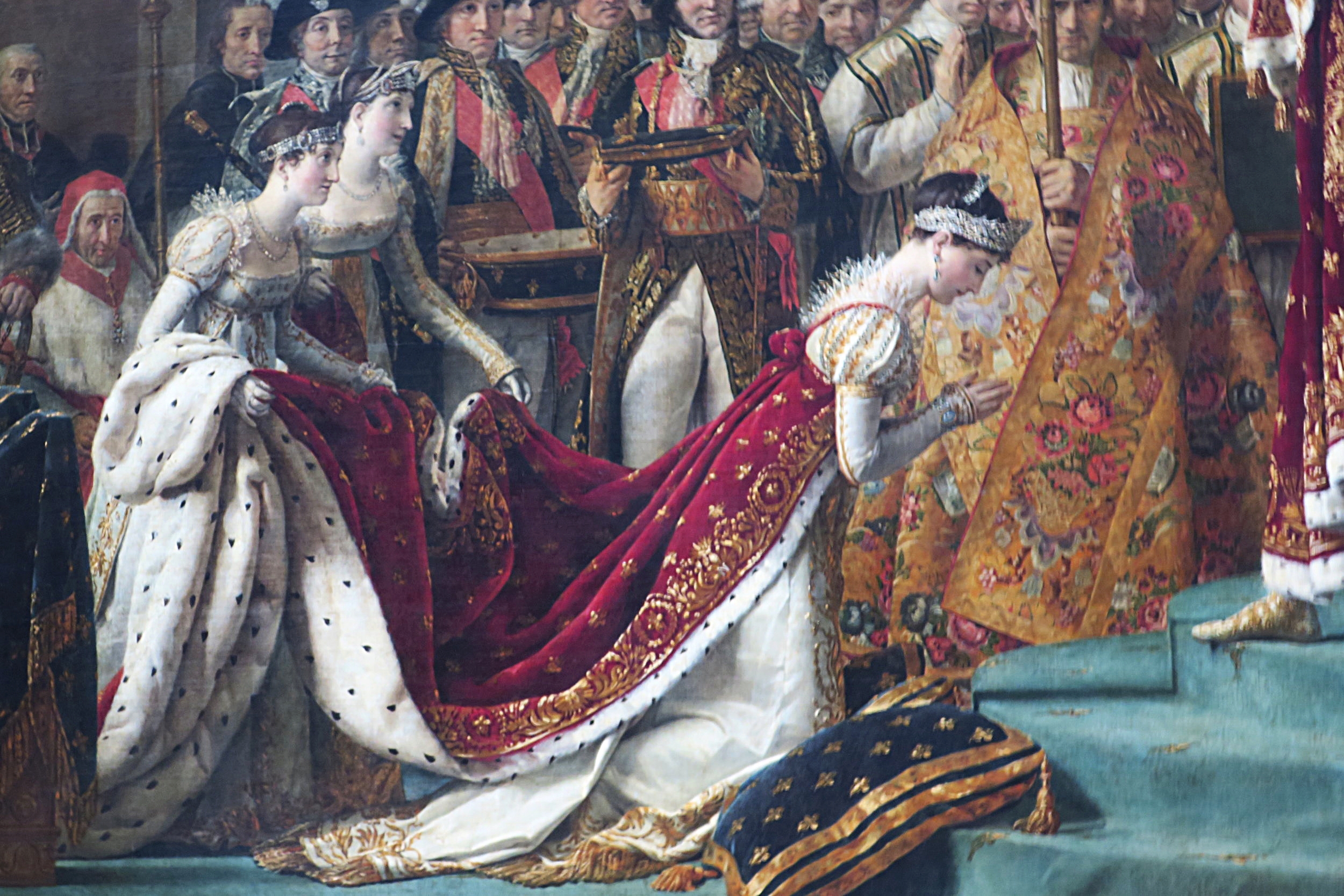Not exactly hidden, but away from the key moments within Jacques-Louis David’s monumental tableaux “The Consecration of the Emperor Napoleon and the Coronation of Empress Joséphine on December 2, 1804” are a few pieces you can find today. The royal regalia used on this day and depicted in this painting include the Crown of Charlemagne, Scepter of Charles V and the Sword of Charlemagne all of which can be seen in the Musée du Louvre. It’s the living breathing pieces of history that are my very favorite parts of Paris. to unwrap and explore.
The Crown of Charlemagne was the name given to the coronation crown of the Kings of France dating back to 1237. Named for the great medieval King of the Franks and Holy Roman Emperor Charlemagne was first used to crown his grandson, Charles the Bald. A simple band topped with fleur-de-lis was added onto over time with jewels and velvet cap. A matching open worked crown was made for the coronation of the queens, but only one would survive the 1590 Siege of Paris. The surviving crown would be used all the way until the last King of France was crowned in Reims, Louis XVI. The crown would then be destroyed during the French Revolution, never to be seen again.
When it was time for Napoleon to take his throne of power over France he of course needed a crown. Martin-Guillaume Biennais was given the task. Using drawings from the 15th C of Charlemagne and a bust Napoleon had once seen in Aix-la-Chapelle showing the Emperor topped with a crown covered with cameos and carnelian jewels the design was born. Eight cameo covered arches attached to a band, come together at the top and are met with a gold cross. In the painting the crown can be faintly seen on the left in the hands of le marechal Kellerman. (seen between the two men in the dark hats) At the actual event, Napoleon, being Napoleon picked up the crown and placed it on his head over his laurel wreath, crowning himself Emperor of France
.The scepter of Charles V dates back to the 14th century and is one the few remaining pieces left of the medieval French reliquary. Created for the coronation of the son of Charles V in 1380, it would then be used by every ruling sovereign up until the very last, Charles X in 1825. Sitting on a lily, that was originally enameled white, is Charlemagne on a throne. In his left hand, he holds an orb that represents the world, topped with a cross. In the large painting, David depicted the scepter in the hands of Le marechal Perignon just to the right above the Crown of Charlemagne.
Both the crown and the scepter can be seen today in the Musee du Louvre, in the Richelieu Wing on the 1st floor in salle 504, it’s rarely crowded and something you must see.
In the Notre Dame de Paris, the site of this monumental event sits in the chevet behind the choir in the Chapel of Saint George a mostly unnoticed set of candlesticks and a crucifix. At the time the cathedral was falling into disrepair and needed a lot of work to be ready for the coronation. Tapestries with the eagles, the royal bees, crowns, laurel wreaths and N’s were hung to cover the pillars that were falling apart. Galleries and raised seating was built to hold the royal onlookers and even a new altar would be built.
In addition, placed on the new altar would be a set of large candlesticks and a crucifix brought from the Arras Cathedral. Today in the Chapel of Saint George against the stained glass windows depicting the life of Saint Stephen those same candlesticks can be seen. Jacques-Louis David did an amazing job representing them in his large piece that would commemorate the day. The altar they sit upon is a recreation in 1976 of the one that was in the cathedral at that time of le sacre de Napoleon.
There are countless more amazing things to notice in this painting, the true moments of that historic day and some that were added in to alter is along the way. I hope the day never comes that I actually learn every one of those small elements that make this one of my favorites works of art.













